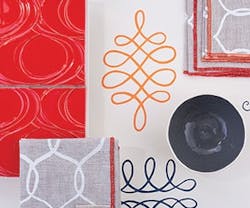In the words of materials designer Sarah Miller, “there is possibly no better way to understand people than by assessing their stuff.”
This past year, Miller partnered with Invision (where she worked as a senior designer from 2007 to 2011) to create Objects Made, a curated exhibition of handcrafted products and the design trends they represent.
The idea began with Invision’s Corporate Vice President of Marketing Ross Leonard, who saw a two-way learning opportunity in taking a trends presentation on the road. “We want to become more design literate ourselves, and to really engage the design community more,” he said, noting that the Invision design team immediately identified Miller as the perfect person to lead the project’s development.
They gave her the freedom to explore without constraint—no easy task given the vast range of emerging trend indicators to examine. Then Miller found the New York Times article “In Fashion, Are Trends Passé?” proclaiming the demise of trends as we know them. “Increasingly, trend reports rank fairly low on consumer checklists,” it read. “Shoppers instead glean their fashion intelligence from a welter of sources, among them the runways, the Internet, and the streets.”
“It got me thinking about how I was going to approach the project,” Miller recalled. “The trends are not top down anymore; they’re coming from the bottom up in a lot of cases. I started my research from the ground up, and just focused on people and objects and interesting things right here in the very cultural hub I’m currently living in.”
The result was an organic journey through a sea of artisans and craftspeople in Miller’s hometown of Portland, Ore. She was welcomed into the studios—and in many cases, the homes—of 21 designers to learn first-hand about their philosophies and processes as makers.
While Sarah did identify four traditional aesthetic trends , she also uncovered 10 common ways of working, which encapsulate a modern ethos of design and reflect larger movements in our society and culture.
“Once Sarah got involved, it kind of morphed from what was maybe your more conventional, less original, typical trends presentation, to a more meaningful study of the creative process,” Leonard said.
The Objects Made designers span categories from fashion to furnishings to toys, but all of their design work can be summed up by a single, overarching word: authentic.
“Time and time again, it confirms as a designer that the process is not completely different across different industries or products,” Miller said. “They all sort of follow a similar process beginning to end, if you were to boil it down to the simplest steps.”
The current maker movement is a tangible reflection of our search for meaning in a mass-produced, digital age. This modern counterpoint to the Industrial Revolution values handmade craft, unique items, a deep respect for materiality and for the skills of makers who manipulate them, and a willingness to collaborate and customize.
“It’s looking back to move forward, mixing the old world with the new world, taking something that’s old but making it modern, or making something that’s modern but referencing the past,” Miller said. “It’s a mix of the two that right now makes things feel good.”
The movement is modern, to be sure, and technology is a critical component—both in the production process and as a means of disseminating the message. The trends that now start at the grassroots level are rising up through social media, and through the eyes of careful design scouts like Miller herself.
10 Design Trends
Through her research and explorations, Sarah Miller uncovered 10 common ways of working that encapsulate a modern ethos of design, and reflect larger movements in our society and culture. Click below to see the 10 points and the designers who embody them.
Click here to view the JPG
Click here to view the PDF
Now, national retailers such as Anthropologie and J.Crew are commissioning the work of local artisans, further blurring the lines between craft and mass produced product. “It’s creating a lot of awareness for what the artisans are doing, and shows [the large retailers’] consumers they care about that.”
But how does this translate into the contract design market? For mid-sized contract manufacturers like Invision, it’s about built-in flexibility and a willingness to experiment like the makers do.
“In a way, [Objects Made] kind of reinforces how important it is for products to have a point of view, whether it’s furniture, or seating, or a floorcovering,” Leonard said. “As a smaller manufacturer, we’re somewhat different in that we can be a little more nimble from a manufacturing standpoint. We don’t have to make a product that’s going to sell 20 million yards a year. We can experiment a little bit and take risk and create products that perhaps are a little more personal.”
Of course, from product trends follow interior design trends. Here, end-users are so removed from the design and specification process that the quest for “authentic meaning” poses a big challenge—but not one that is impossible to overcome, according to Miller, so long as “choices are made with an intention and with a concept in mind.”
“If someone is really paying attention to the yarns they’re selecting and the color palates they’re putting together, the way they’re mixing the yarn, the machine they’re using—whether you’re designing contract, residential, or consumer goods, if you’re giving the product that kind of awareness, it will show up,” she said. “There will be something special about it.”
Objects Made will also be coming to Atlanta, Minneapolis, Houston, and Portland in 2014! Visit the Inside Sources blog at for more information and upcoming dates.
